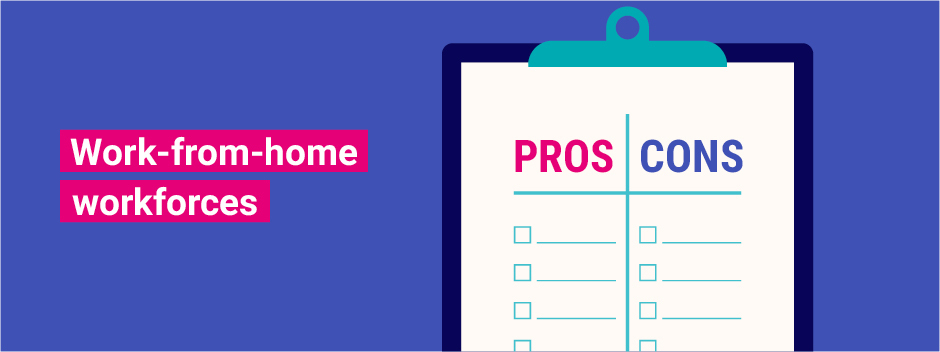Some found it worked better than expected; others grappled with unforeseen challenges. Whatever the outcomes, this experience has opened up the possibility of remote working to businesses who hadn’t done it before. And while many have now returned to the workplace, others may be considering remote working in a new light.
Dan Auerbach is a workplace psychology consultant and Director with Associated Employee Assistance Providers. He says there are ways to combat the downsides of managing a work-from-home workforce and benefits to the business if you get it right.
The challenges
- It’s not for everyone
Humans are social beings, and some will struggle with the lack of face-to-face connection. Others are not as technically-savvy. On the flip side, there are those who’ll relish the improved focus that comes from less distraction and interruption.
Auerbach says it’s important to provide opportunities for your staff to interact. That could be planning occasional social get-togethers, virtual Friday afternoon drinks or modifying your roster.
Remote work doesn’t have to be all or nothing – it’s about implementing it in a way that works for your team. “Be flexible with people,” he says. “Allow those who are task-oriented to work from home as much as works for the company, while allowing those who require interaction to perform more strategically in groups.”
Remote working won’t suit all roles, all industries or all people, but a flexible work environment does enable your business to access talent from outside your usual recruitment pool.
- Time management
Keeping staff on track can take a bit more effort when they’re dispersed. Auerbach says professional training is available to help staff become more productive in this new environment.
“Not everyone is going to have the internalised boundaries that tell them when to work or how to work,” he says. “Some are going to need closer supervision and their manager may need to create a formal structure to measure performance. Be more conscious about following up with people when not in a shared environment.”
Consider what it is that makes different employees thrive. Are they more motivated around other people? Would they benefit from more regular, shorter breaks? Or would more touch points during the day help them know if they’re still on track?
- Employee burnout
Overworking is one of the big dangers to watch out for in your remote-based employees, warns Auerbach.
It’s a lot harder to see the signs an employee isn’t okay – change in body posture, drop in self-care, withdrawal – when you’re not under the same roof, so managers have to be much more proactive about checking on staff and provide them with the skills to detach from work at the end of the day.
“I believe that anonymity of working from home is going to expose employers to a lot of occupational health and safety issues if they don’t get on the front foot,” says Auerbach.
SEEK’s Resident Psychologist Sabina Read has some advice on how to have mental health conversations with your team.
The advantages
- Employee satisfaction
Remote working has given people more control over how to divide their time. For many of us, it’s meant seeing more of our families, spending less time commuting, having more time for exercise, wearing what we want and fewer meetings to be held up by.
As a supervisor you can enhance employee satisfaction by providing clearly defined tasks, ensuring staff have the right tools for remote work, and giving positive reinforcement so your staff feel supported and valued.
Given the significant retraining costs associated with staff turnover, having a workforce that has a better work life-balance, less stress and improved job satisfaction can boost your retention rates, says Auerbach.
- Increased productivity
Auerbach says a lot of his clients are reporting increased productivity under work-from-home arrangements.
People aren’t starting their day with the stress of the commute, they spend less time in meetings, and have fewer day-to-day distractions to pull them off-task.
He says encouraging staff to value and protect their own personal time can give them added motivation to perform
- Cost savings
Fewer workers in the office can mean reduced space requirements and fit-out costs. Plus, the flexibility means employees don’t necessarily need to take a whole day off if they have an appointment or other obligations.
Auerbach suggests investing money saved on rent, employee expenses and travel into providing your workforce with the skills to become more productive at home. Whether it’s time management training, improving your systems or offering health and wellbeing programs your team needs, this investment could help you overcome your biggest obstacles.
Is it worth the extra effort?
While some businesses may have found it difficult to adapt to this new way of working, it’s important to recognise it’s found favour in the eyes of the worker.
Thirty per cent of people believe they’ll work from home more often than they did before the pandemic, and 2 in 3 Australian job seekers now say they’d choose to work from home at least once a week if they had the choice. Two days a week is the most popular option.
Auerbach says workplace flexibility will be a defining factor in being an employer of choice. “It was on the cards for a long time, trialled by various workplaces, and now it’s going to be essential if you want to compete,” he says.
Source: Independent research conducted by Nature on behalf of SEEK, interviewing 4800 Australians annually. Published November 2020.

